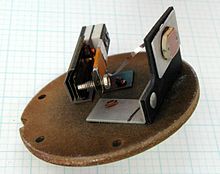- Photoresistor
-
 A light dependent resistor
A light dependent resistor
 The internal components of a photoelectric control for a typical American streetlight. The photoresistor is facing rightwards, and controls whether current flows through the heater which opens the main power contacts. At night, the heater cools, closing the power contacts, energizing the street light. The heater/bimetal mechanism provides a built-in light level transient filter.
The internal components of a photoelectric control for a typical American streetlight. The photoresistor is facing rightwards, and controls whether current flows through the heater which opens the main power contacts. At night, the heater cools, closing the power contacts, energizing the street light. The heater/bimetal mechanism provides a built-in light level transient filter.
A photoresistor or light dependent resistor (LDR) is a resistor whose resistance decreases with increasing incident light intensity. It can also be referred to as a photoconductor or CdS device, from "cadmium sulfide," which is the material from which the device is made and that actually exhibits the variation in resistance with light level. Note that CdS is not a semiconductor in the usual sense of the word (not doped silicon).
A photoresistor is made of a high resistance semiconductor. If light falling on the device is of high enough frequency, photons absorbed by the semiconductor give bound electrons enough energy to jump into the conduction band. The resulting free electron (and its hole partner) conduct electricity, thereby lowering resistance.
A photoelectric device can be either intrinsic or extrinsic. An intrinsic semiconductor has its own charge carriers and is not an efficient semiconductor, e.g. silicon. In intrinsic devices the only available electrons are in the valence band, and hence the photon must have enough energy to excite the electron across the entire bandgap. Extrinsic devices have impurities, also called dopants, added whose ground state energy is closer to the conduction band; since the electrons do not have as far to jump, lower energy photons (i.e., longer wavelengths and lower frequencies) are sufficient to trigger the device. If a sample of silicon has some of its atoms replaced by phosphorus atoms (impurities), there will be extra electrons available for conduction. This is an example of an extrinsic semiconductor. Photoresistors are basically photocells.[2]
Contents
Applications
Photoresistors come in many different types. Inexpensive cadmium sulphide cells can be found in many consumer items such as camera light meters, street lights, clock radios, alarm devices, and outdoor clocks.
They are also used in some dynamic compressors together with a small incandescent lamp or light emitting diode to control gain reduction.
Lead sulphide (PbS) and indium antimonide (InSb) LDRs (light dependent resistor) are used for the mid infrared spectral region. Ge:Cu photoconductors are among the best far-infrared detectors available, and are used for infrared astronomy and infrared spectroscopy.
References
See also
- Optoelectronics
- Photodiode
- Phototransistor
External links
- Using a photoresistor to measure nocturnal light levels - The Moonlight Sensor
- Using a photoresistor to track light
- Connecting a photoresistor to a circuit
- Photoresistor overview - detailing operation, structure and circuit information
Categories:- Resistive components
- Optical devices
- Sensors
Wikimedia Foundation. 2010.

